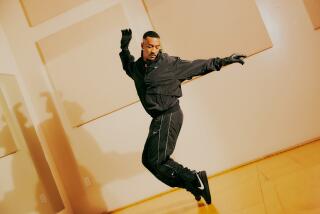His Drum-and-Bass Is Served With Some Spice
- Share via
Dance music is still sometimes derided as the most vacant form of pop--a musician-less world of blips and bleeps where no one does the talking and machines do all the walking.
And yet today this diverse and universal medium is also arguably the most vibrant form of pop, which has always relied on technology and hybridization for its evolution. A small group of virtuosos have led the way for dance music’s artistic rise, people such as DJ Shadow, Goldie and Liam Howlett of Prodigy.
And certainly you can add to this list Talvin Singh, a new name to America who has nonetheless wowed the critics by producing a just-released compilation of drum-and-bass: “Anokha: Soundz of the Asian Underground” (Quango). The collection is already hovering on college radio, world music and dance album charts.
Singh, a 27-year-old Londoner of Indian descent, was best known for his collaborations with left-field dance acts such as Bjork and Massive Attack. But by as early as age 5 he was studying classical Indian music and learning the complex language of the drum known as the tabla. By the time he was a teen, drummer Singh was mixing it up with jazz artists Sun Ra and Courtney Pine. Add this experience to England’s hyper-speed hip-hop revolution called drum-and-bass and you have the refreshing hybrid of Indian-flavored techno that fills his new compilation.
Anokha (Hindu for unique) is the name of Singh’s popular club night at London’s Blue Note. And it came just in time: Drum-and-bass has become trendy and perhaps even cliched, with artists ranging from the Fugees to Erykah Badu getting the “jungle” remix treatment. But the cutting edge of drum-and-bass is feeling its way into jazz, experimental electronics and, of course, ethnic tastes.
“I got out of the jazz scene because I found the audience and the people involved boring,” Singh says. “It became too comfortable. I see drum-and-bass as jazz music because it’s really open to things. I see it as future jazz.”
‘Anokha” features the fervent beats of the tabla interlaced with furious snares and cool Indian strings. But it is not so complex that it gets bogged down in the vernacular of music: It’s a free ride on the Underground through ethnic East London, the smell of Indian spice flowing through its sound waves.
His objective was to represent the eclectic vibes of Asian East London. But in the process he has lent unprecedented credibility to the British wave of dance, challenging Western-centric notions of the superiority of melody and lyrics over rhythm and emotion.
“A lot of people are now using drums and rhythm as the forefront for the music, and melody as the environment,” he says. “In electronica you’re using pulses and frequencies as sound rather than musical notes. . . . In Hindu mythology, this time in our history is the time of the drum.
“In the West, lyrics have been given too much importance. Always in the West in the beginning, music was based on literature and narrative form, and people didn’t get their heads around music for mind, body and spirit. And dance music has tapped that.”
Dance music’s latest arrival is buoyed by the sales of albums such as Prodigy’s “The Fat of the Land,” which recently debuted at No. 1 on the U.S. charts. But doubters still wonder if people want to dance more than they want to rock.
“I think dance music and instrumental music is going to get even more popular,” Singh says. “People are going to start listening to music to chill out, not in a hippie way, but people are going to get into good music from all over the world. The genres are going to fragment, but the world is becoming smaller.”
*
* Talvin Singh is scheduled to deejay on Aug. 7 at Quango Sound Lab at LunaPark, 665 N. Robertson Blvd., West Hollywood, 10 p.m. $15. (310) 652-0611.
More to Read
The biggest entertainment stories
Get our big stories about Hollywood, film, television, music, arts, culture and more right in your inbox as soon as they publish.
You may occasionally receive promotional content from the Los Angeles Times.










